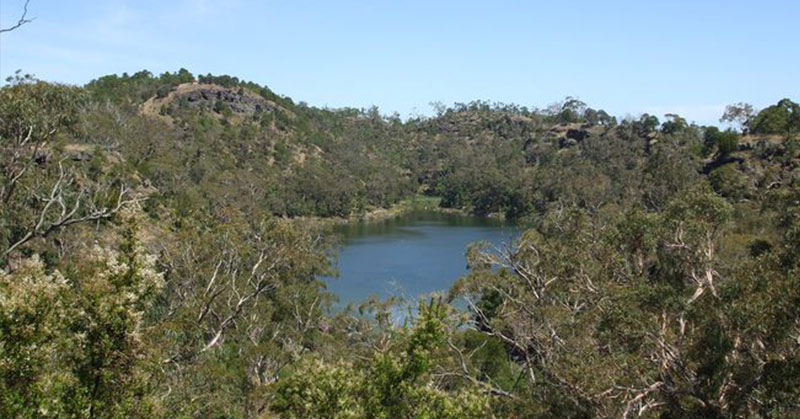The recent bushfires in Australia have devastated the country. As of January 24, 2020, the total area affected across all states is 7.7 million hectares (19 million acres). This has claimed the lives of at least 32 people, destroyed nearly 2000 homes, and has decimated the country’s wildlife population [1]. The Australian bushfires have been one of the most catastrophic natural disasters the world has ever seen, but sometimes it takes a disaster to reveal to us something that we didn’t fully know was there. An ancient water system thought to be older than the pyramids of Egypt has been found.
The Budj Bim Water System
After the fires burned away the dense vegetation that covered it, the sprawling Budj Bim water system was revealed in all of its former glory [2].
The system of channels, weirs, and dams was built by the Dhauwurd Wurrung, or Gunditjmara people, who were the ancient inhabitants of that land. It was used to trap the eels that swam in those waters upon which the people depended for food [2].
The Budj Bim is more than six thousand years old and is the oldest known system of its kind in the world. By comparison, the Giza pyramids are less than five thousand years old [2,3].
Previous to the bushfires, no one knew just how vast the water system was. The fires revealed that Budj Bim is much larger than previously recorded. “When we returned to the area, we found a channel hidden in the grass and other vegetation. It was about 25 meters (82 feet) in length, which was a fairly substantial size,” said Denis Rose of the nonprofit group Gunditj Mirring Traditional Owners Aboriginal Corporation [4].
How Did The Budj Bim System Work?
The ancient Gunditjmara people used the natural materials they had available to them to build the dams. In this case, that meant using the volcanic rocks that abounded in the area from the now-dormant volcano Mount Eccles [2,4].
The dam redirected the waters from Lake Condah, where there was a massive population of short-finned eel called Kooyong. The ancient indigenous people weaved long funnels out of river reeds and spear grass, which allowed the smaller, younger eels through into a larger catchment area so they could grow. This was their way of managing the seasonal variation of supply [2,5].
Rose describes the system of farming that worked together with the natural flow of the water:
“This was a place where Gunditjmara people actually engineered or manipulated the natural system to enhance production of eel,” Rose said [5].
Many indigenous Australian people lived semi-nomadic lives, but with their aquaculture system along with other wildlife as a source of food, the Gunditjmara people were able to sustain themselves year-round. As such, they set up permanent dwellings, and the evidence of these primitive homes can still be found today [5].
The Gunditjmara People
The Gunditjmara people are one of the indigenous groups of Australia. They established permanent settlements in what is now Glenelg Shire in southwestern Victoria up to thirty thousand years ago [6].
Their first contact with Europeans occurred sometime between 1800 and 1830, and as with many indigenous populations, this is when their massacre began. At one time numbering seven thousand people, the population of the Gundjitmara is now down to 440. Throughout the generations since, these people have experienced significant trauma and suffering, shootings and murders, have been run off their traditional land, and have had their children taken from them [6].
The Budj Bim lands were turned into fields for cattle, and the water was drained for usage elsewhere. The Gunditjmara people, however, refused to leave their land and many of them died trying to protect it [5].
The Gunditjmara Aboriginal Cooperative was established in 1982, and they began fighting to take back their land and restore its natural resources. Today, the cooperative manages three thousand hectares (7 413 acres) with the goal of preserving the ancient heritage and healing the land [5].
An Achievement That Stands the Test of Time
This new discovery is very important to the Gunditjmara people. It is a testament to the ingenuity of their people, and its recognition as a World Heritage Site is an important acknowledgment of the work that their ancestors have done [2].
Although it took a tragedy to reveal its full scope, the 6 600-year-old Budj Bim has stood the test of time. As Rose tells everyone who visits the area “there’s not many things on the planet that still exist today that are older than that.” [2]
Read More:
Indigenous Canadians in Water Crisis as Nestlé Drains a Million Gallons a Day From Their Land
- https://www.theguardian.com/australia-news/datablog/ng-interactive/2019/dec/07/how-big-are-the-fires-burning-on-the-east-coast-of-australia-interactive-map
- https://www.mnn.com/lifestyle/arts-culture/stories/budj-bim-aquatic-system-fires-australia
- https://www.nationalgeographic.com/history/archaeology/giza-pyramids/
- https://www.cnn.com/2020/01/21/asia/budj-bim-australia-bushfire-intl-hnk-scli/index.html
- https://www.aljazeera.com/news/2019/10/blood-water-australia-budj-bim-global-recognition-191027235046739.html
- https://glenelglibraries.vic.gov.au/historictreasures/stories/our-rich-indigenous-history

